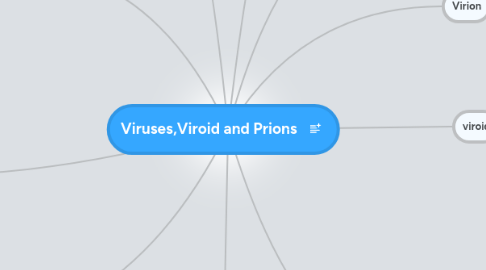Viruses,Viroid and Prions
by Muhammad Adam


1. Host Range
1.1. - determine by presence of specific receptors - example host : 1) invertebrates 2) vertebrates 3) plants 4) protists 5) fungi 6) bacteria
2. Size
2.1. smaller than bacteria
2.2. wide range
2.3. only can be seen using electron microscope
2.4. unit : nm
3. DNA viruses
3.1. adenovirus
3.2. papovavirus
3.3. herpesvirus
3.4. hepadnavirus
3.5. release into nuclues of cell
4. RNA viruses
4.1. picornavirus
4.2. togavirus
4.3. rhabdovirus
4.4. retrovirus
5. General Characteristics
5.1. - not retained by bacterial filter - not visible-light microscope - intracellular parasite - contain sgle type nucleic acid - protein coat - multply inside living cell
6. Viral Structure
6.1. nucleic acid
6.1.1. have either DNA or RNA
6.1.2. not both
6.1.3. sense of strand
6.1.4. segmentation
6.2. Capsid
6.2.1. protection and attachment
6.2.2. architecture : - helical -polyhedral -enveloped -complex
6.2.3. example : -icosahedral -pleomorphic -cylindrical
6.3. Envelope
6.3.1. protein
6.3.2. lipids
6.3.3. carbohydrates
7. Virion
7.1. intact,fully assembled and infective virus
8. viroid
8.1. piece of RNA without a protein coat
8.2. plant infected
8.3. smaller than virus
8.4. consists single circular RNA
8.4.1. low molecular weight
8.5. exist inside cell as particles of RNA without capsid
9. Bacteriophages
9.1. Replication/Multiplication
9.1.1. lytic cycle
9.1.1.1. cell died
9.1.2. lysogenic cycle
9.1.2.1. remain alive
